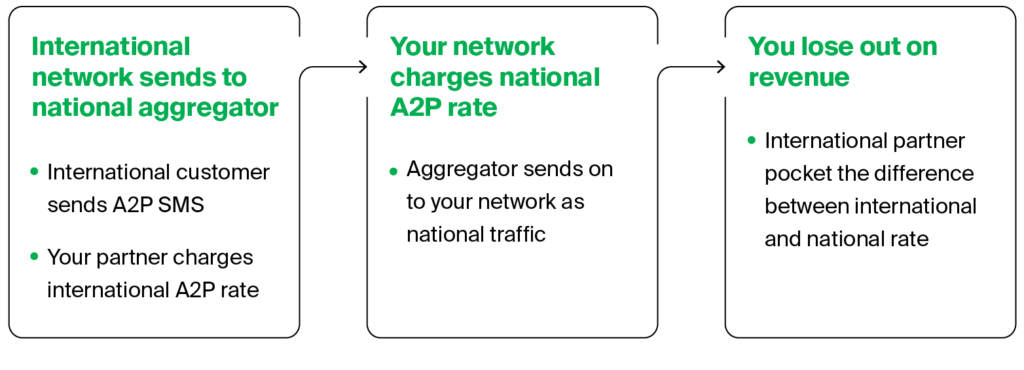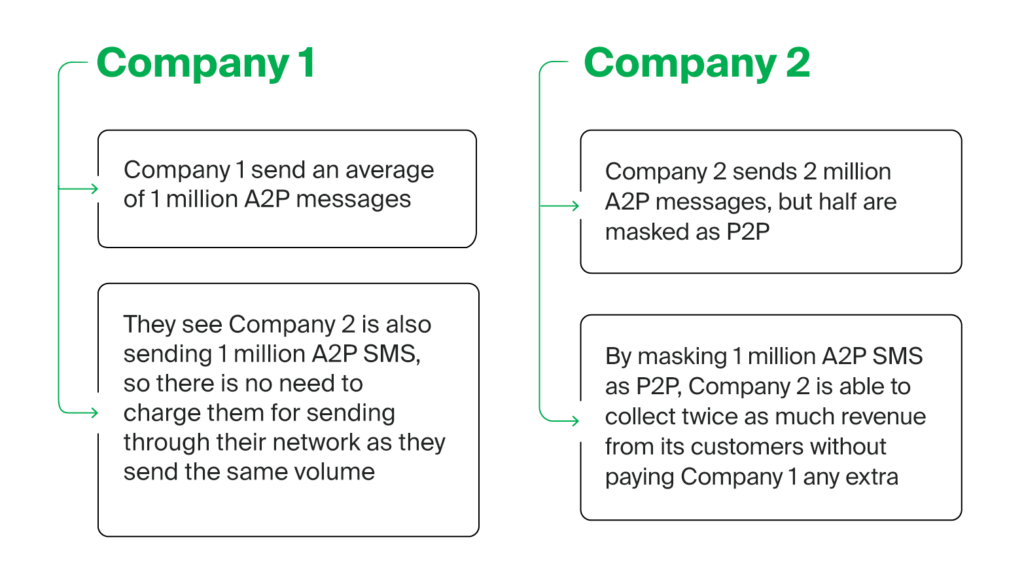Grey routes are a hot topic in the telecoms industry — and rightfully so, as they are a serious threat to operators. If you’re unfamiliar with what a grey route is, they’re essentially a method used to send SMS traffic that isn’t fully monetised by an MNO.
A2P and P2P traffic are monetised differently, and in many cases, P2P makes almost no profit and is even price controlled by the state. Third parties often use grey routes to send A2P SMS disguised as P2P to avoid higher costs. This already sounds like a pretty serious issue, but it’s also much more widespread than many imagine — a report by Juniper Research showed that 30% of A2P SMS traffic wasn’t properly monetised, and a 2021 study by Mobilesquared and Vox predicted that grey routes will cost MNOs $37.1 bln over the next three years.
Understanding what grey routes are is the first step to combating their impact on the industry, but what’s the next step? We need to identify the different methodologies for accessing or using these grey routes.
Local flavour
A lot of grey routes are about hiding A2P traffic as P2P traffic because of the difference in pricing between the two, but when looking at A2P pricing, there’s also a difference between national and international A2P pricing. An unscrupulous international partner can use a local aggregator that sends A2P traffic in your country at the lower national rate to avoid paying you in full for the service you’re providing.
As we’ve seen, most grey routes are about masking traffic, but this is a particularly insidious one as the foreign operator is still taking advantage of you even though they are sending A2P traffic. They’re charging the sending customer the international A2P rate and only paying the national A2P rate through their local aggregator partner.

How can you protect against this kind of fraud? You need to monitor the traffic on your networks constantly, 24/7, 365 days a year. If you know your network traffic, and you know what your individual partners send. When you see a local aggregator sending traffic that would be unusual for a company of that kind, you should investigate the content of the SMS being sent. Taking a look at the content, it is often obvious when that content has been generated by an international partner, and once you have discovered this, you can take action to prevent this from happening again.
“What’s in the box?”
The answer is — a lot of SIM cards. One of the most prevalent grey routes is international bypass fraud, commonly known as SIM box fraud. We recently wrote a whole article on how SIM box fraud works and what GMS does to combat it, which you can read in more detail here.
The fraudster in question has a “box” that is filled with hundreds of cheap prepaid P2P SIM cards located in your country. They funnel A2P messages to this box, where they are then sent out from the P2P SIM cards as if they were P2P messages. The fraudsters in question will make their money on the difference between the costs their customers paid to send the A2P SMS and the price you charge to send P2P SMS. Sometimes the prepaid SIMs they buy will even have some free messages included in the purchase price, allowing them to make a bigger profit.
GMS has multiple methods of reducing and even eliminating SIM box fraud. Our team are experts in messaging security and can help you technically with your firewalls to set up rules designed to stop SIM box SMS from being sent on your network. We also have legal and commercial experts ready and on hand to make sure your contracts and commercial offering are built to combat fraud and increase revenue.
Crouching telecom — hidden traffic
When you go into business with a partner in another country, there’s often a lot of trusts involved. You trust your partner to treat you fairly, and they trust you to do the same. But unfortunately, not all partners are deserving of this trust. One type of grey route that is, unfortunately, more common than you might think is between two telecom partners.

As you can see from the above illustration, if one of your partners masks their A2P traffic as P2P, then they can continue to charge their subscribers the full price for A2P but not pass on your portion of the revenue.
In many cases, there’s no easy way to spot A2P messages that have been masked to appear as P2P. Testing is obviously important and can sometimes show you that either the short code has been replaced with a long number (for more on short codes and long numbers, see our article) or the content has been altered to remove details that might identify it as an A2P message.
One of the best ways to protect against this is contractual. GMS’ legal experts can help you examine your contracts to shore them up against this kind of fraud.
Being charged for SMS that is never received
The final grey route we’re going to talk about today is another insidious one, but the reverse of many of the other schemes laid out here as it involves delivering your traffic rather than vice versa. This method is often called blending, but what is actually happening is filtering. Your international partner is reviewing the content that you are sending to them and only delivering the critical transactional messages to their intended recipients.
For example, say one of your customers is a retailer that sends a mix of login support, one-time passwords and promotional messages for new product launches or sales. Your unscrupulous international partner looks at the content you are sending to them and filters out all the promotional messages, sending you faked delivery reports. This way, the recipients won’t notice the lack of messages as everything they trigger will go through as usual. Still, the promotional messages that you are paying your international partner to deliver are going nowhere. The international partner gets to keep the costs it would have taken them to send the messages.
How can you stop this from happening? Well, the best thing to do here is to work with your customers and talk to them about their conversion rates. If nobody is taking up the offers, they are sending out, or the conversions are unusually low, then you’re likely to have an issue on your hands. This could possibly be a technical issue, but it’s always worth looking into to ensure that no fraud occurs.
Don’t forget that SMS has an open rate of 98% and a conversion rate of 45%* — the numbers don’t lie. Check with your partners to see what they’re getting on their international promotional A2P SMS campaigns.
Source: Salesforce
Blending is particularly bad as it will make you lose reputation with your partners rather than monetary loss. This loss of reputation is also bound to lose your business in the long term.
Bricking up the grey routes
Throughout this article, we’ve talked about the ways that GMS tackles grey routes. We’re experts in network monetisation, and we will work with you to ensure that all your traffic is fully and correctly monetised and delivered. If you’d like to take the first step in securing your traffic and your revenue, get in touch with one of our experts today.

